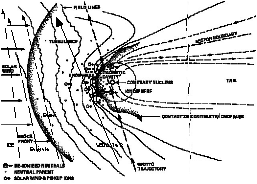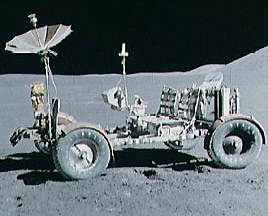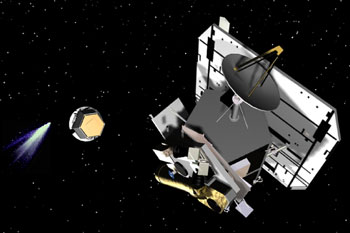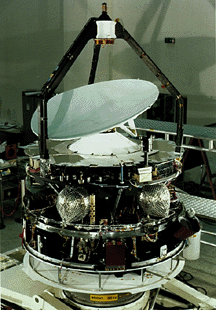Image of Giotto spacecraft
NASA
Giotto
The Giotto spacecraft, named after Italian painter, Giotto di Bondone, who had included Halley's comet in his 1304 painting of Bethlehem, was launched on July 2, 1985. Its mission was to fly by Halley's comet and send back the first pictures of a comet's nucleus and information on its composition.
Giotto's encounter with Halley came on Mar. 13, 1986 at a distance of 596 km (370 miles). This was the closest approach of all six spacecrafts which visited the comet that year, including Sakigake and Suisei.
After four years in hibernation, Giotto was given new instructions and directed toward comet Grigg-Skjellerup. It arrived on July 10, 1992, coming within 200 km of the comet.
You might also be interested in:

Six spacecraft flew by Halley's comet in 1986. There were two spacecraft launched from Japan, Suisei and Sakigake, and two from the Soviet Union, Vega 1 & 2. One spacecraft, ICE, from the United States
...more
The Hubble Space Telescope (HST) was one of the most important exploration tools of the past two decades, and will continue to serve as a great resource well into the new millennium. The HST found numerous
...more
Driven by a recent surge in space research, the Apollo program hoped to add to the accomplishments of the Lunar Orbiter and Surveyor missions of the late 1960's. Apollo 11 was the name of the first mission
...more
Apollo 12 was launched on Nov. 14, 1969, surviving a lightning strike which temporarily shut down many systems, and arrived at the Moon three days later. Astronauts Charles Conrad and Alan Bean descended
...more
Apollo 15 marked the start of a new series of missions from the Apollo space program, each capable of exploring more lunar terrain than ever before. Launched on July 26, 1971, Apollo 15 reached the Moon
...more
NASA chose Deep Impact to be part of a special series called the Discovery Program on July 7, 1999. The Discovery program specializes in low-cost, scientific projects. In May 2001, Deep Impact was given
...more
The Galileo spacecraft was launched on October 19, 1989. Galileo had two parts: an orbiter and a descent probe that parachuted into Jupiter's atmosphere. Galileo's main mission was to explore Jupiter and
...more















